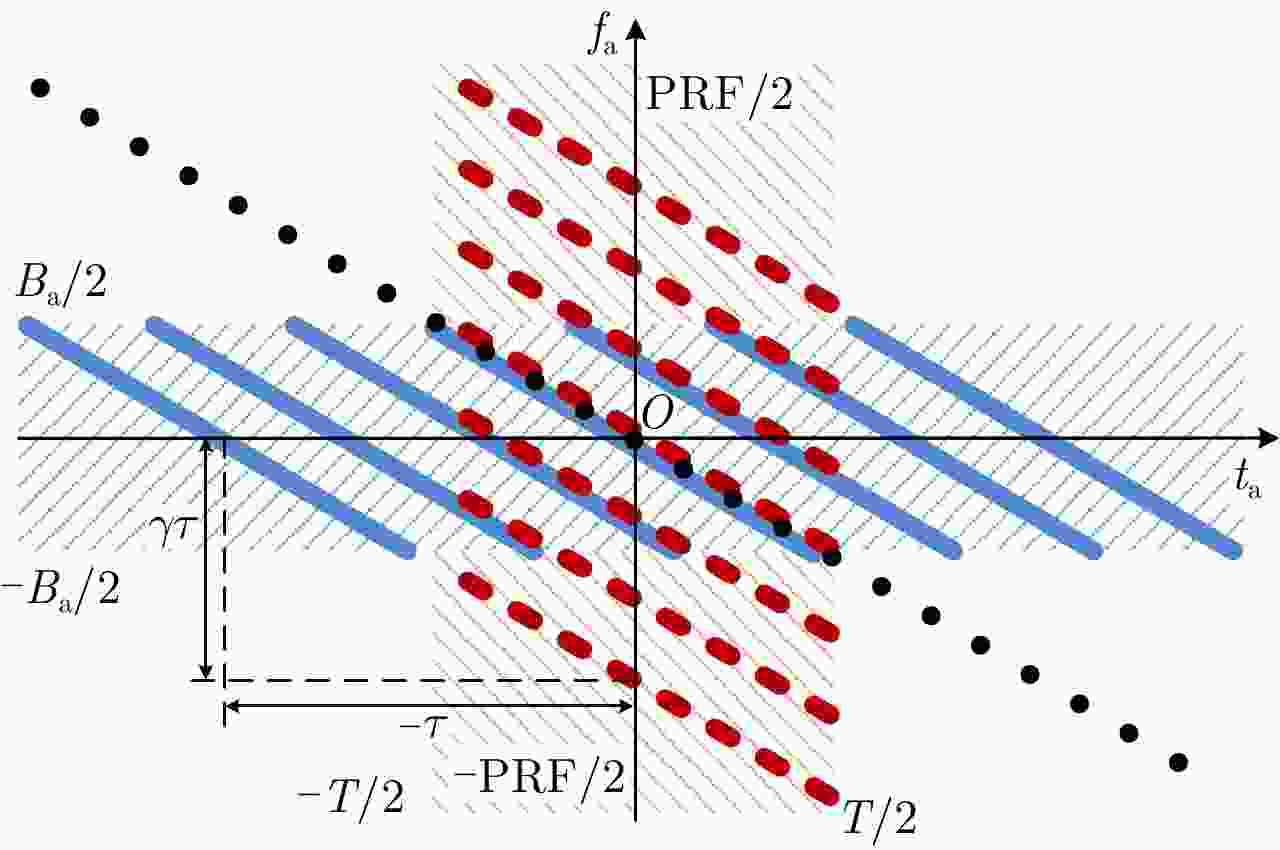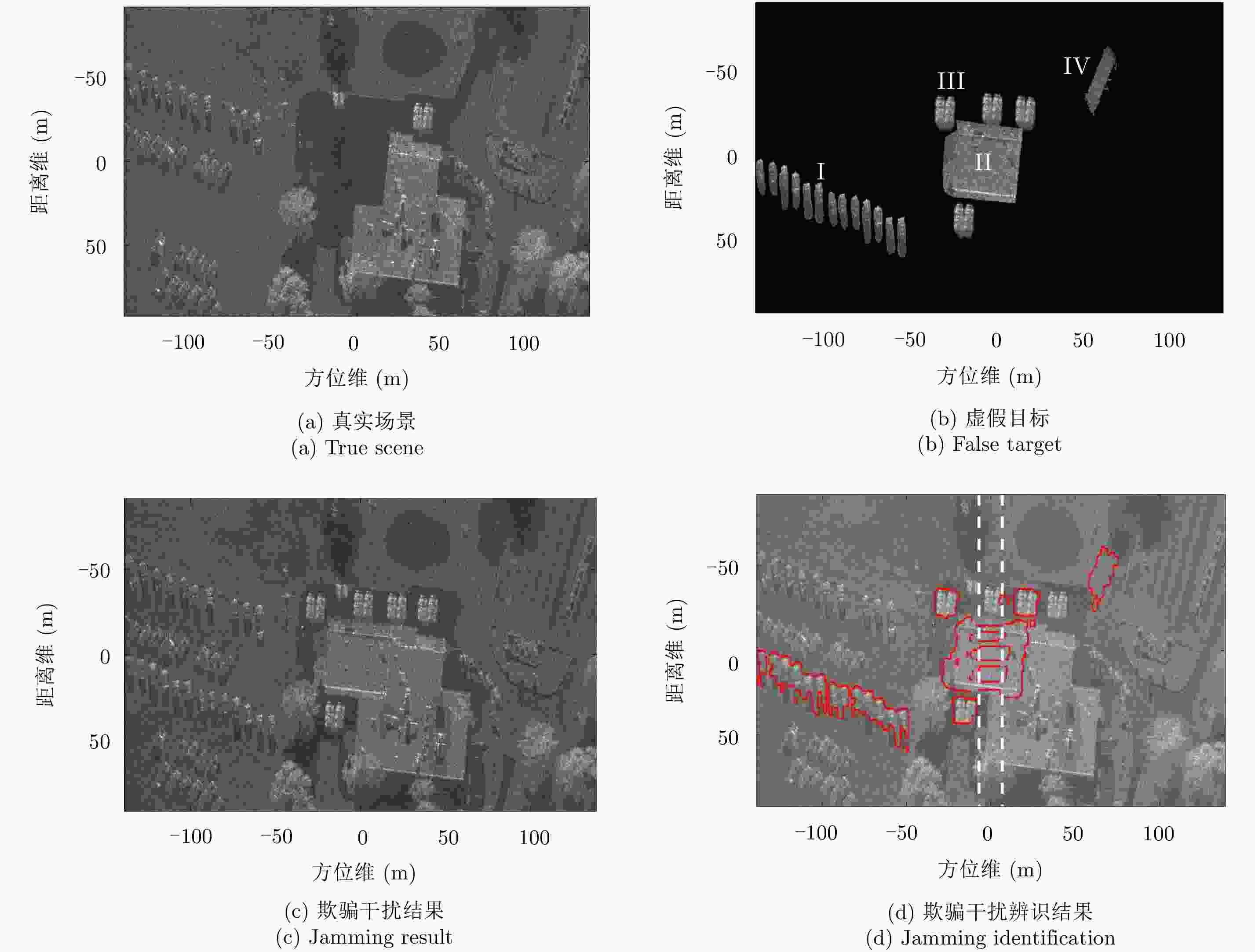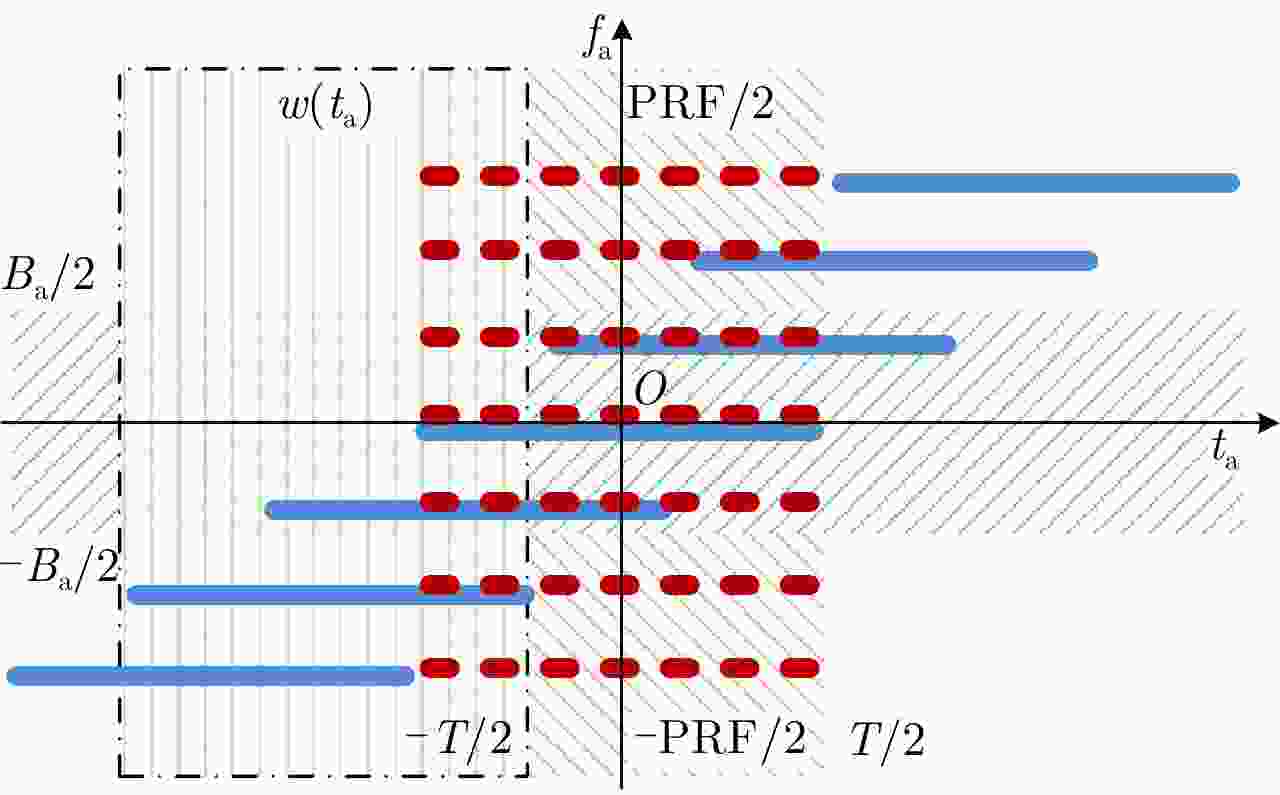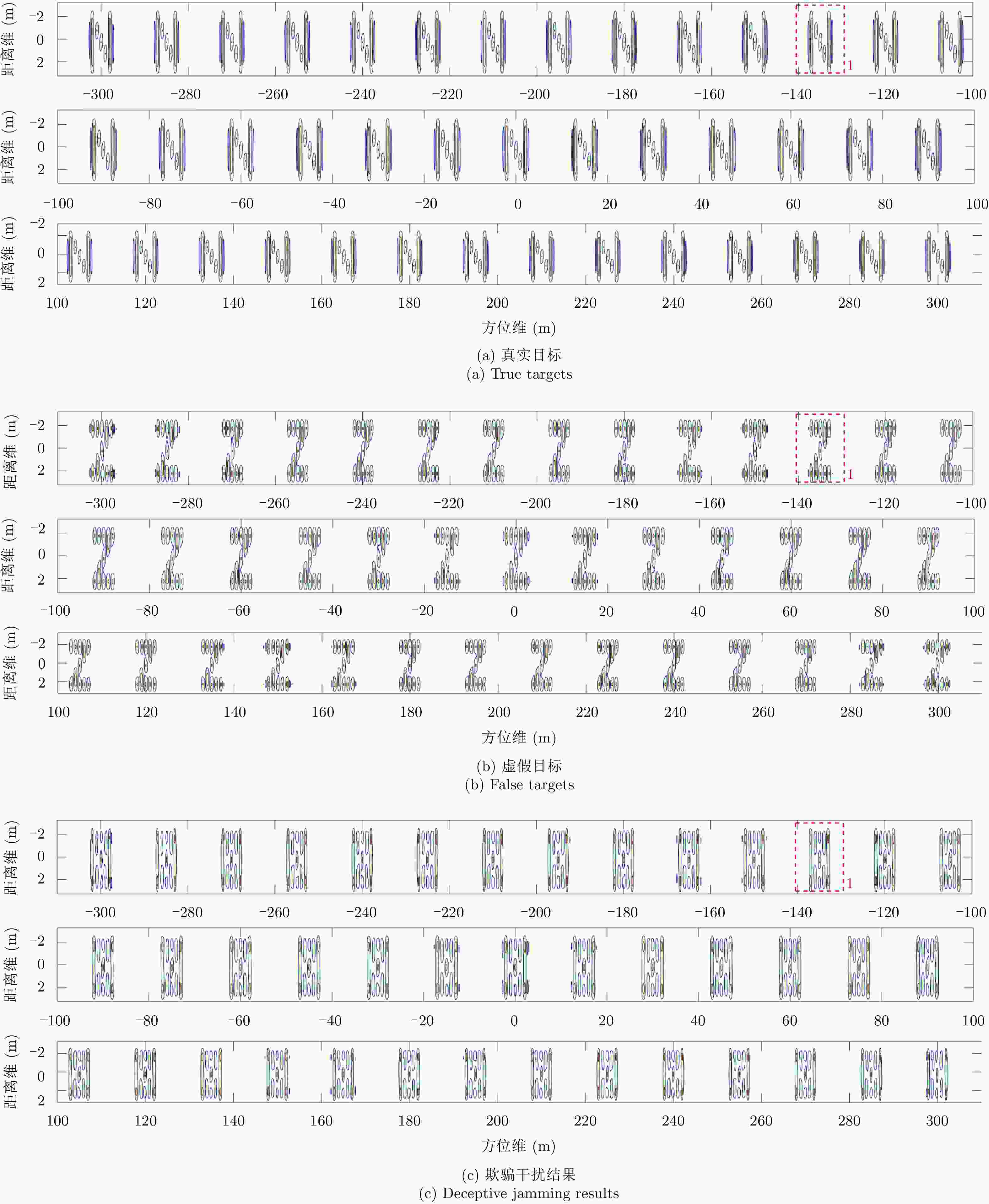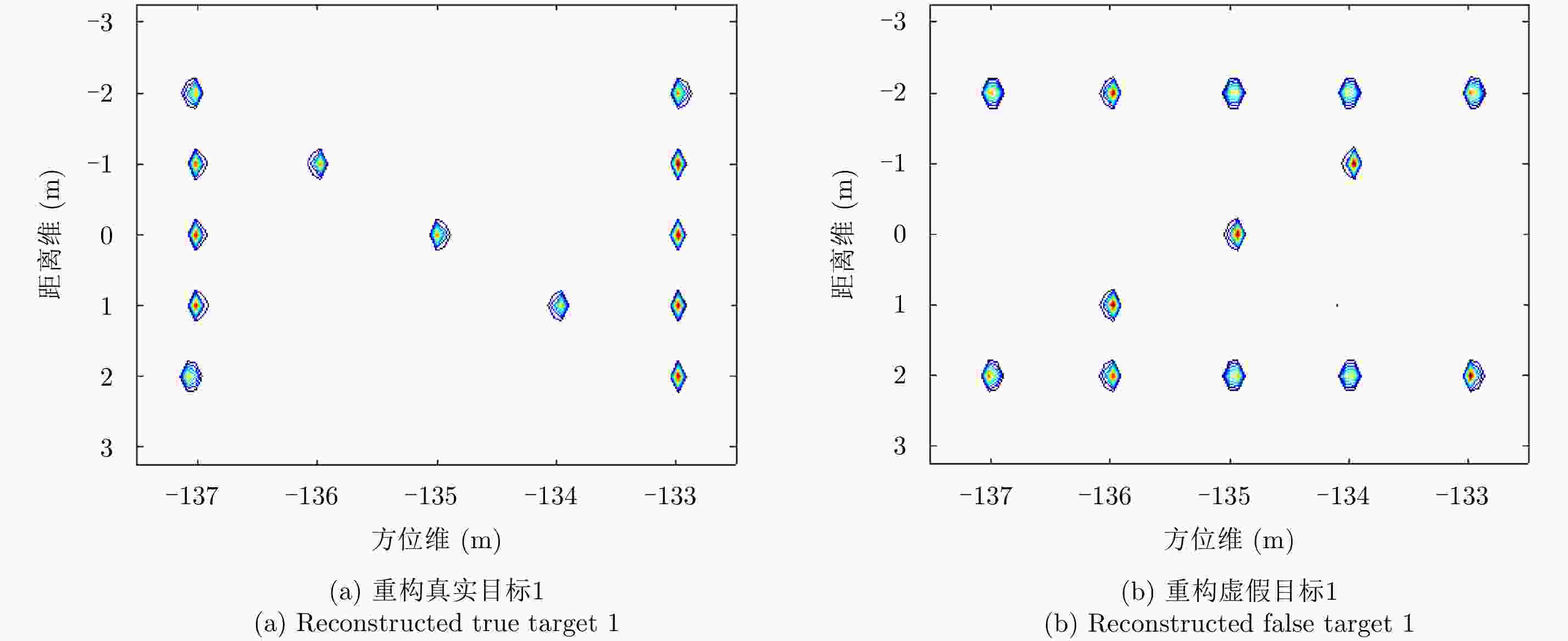-
摘要: 该文讨论了单通道、固定波形SAR成像假设下的抗欺骗干扰方法,在有限的空域自由度与时域自由度下,利用欺骗干扰理论的本质缺陷,有效地提升了SAR系统在复杂电磁环境下的信息获取能力。建立了SAR成像与欺骗干扰的几何与信号模型,根据其各自的工作机理分析真实回波与欺骗干扰的特征差异。采用不同的成像处理流程提取两者各自的特征,并基于统计信息对差异特征进行增强,提高真实目标与虚假目标的分离度,从而实现欺骗干扰的辨识。并进一步采用动态合成孔径处理方法,构造真实目标与虚假目标的优化重构问题,通过对其求解实现两者的超分辨分离重构,达到欺骗干扰抑制的目的。仿真实验验证了该文方法的有效性。Abstract: This paper discusses anti-deceptive jamming methods based on single-channel and fixed waveform assumptions for synthetic aperture radar imaging. Using the essential defects of the deceptive-jamming theory, the information acquisition ability of the Synthetic Aperture Radar (SAR) system in a complicated electromagnetic environment is effectively improved with limited degrees of freedom in spatial and time domains. Geometric and signal models of SAR imaging and deceptive jamming are established and the different characteristics between them are analyzed according to their working mechanisms. Upon extracting their characteristic differences via different imaging processes and enhancing them based on statistical information, the degree of separation between the true and false targets is increased. Therefore, identification on the deceptive jamming is realized. Moreover, an approach for the dynamic synthetic aperture is used to formulate an optimization problem for the reconstruction of true and false targets. By solving such a problem, the true and false targets are separately reconstructed with super-resolution, achieving the goal of deceptive-jamming suppression. The effectiveness of the proposed methods is verified by simulations.
-
表 1 SAR参数设置
Table 1. SAR parameter setting
参数名称 参数值 带宽(MHz) 300 脉冲宽度(μs) 0.5 调频率(Hz/s) 6×1014 波长(m) 0.03 天线孔径长度(m) 1 波束宽度(rad) 0.03 最短斜距(km) 10 平台速度(m/s) 150 斜视角(°) 0 多普勒带宽(Hz) 300 合成孔径时间(s) 2 -
[1] LIU Y C, WANG W, PAN X Y, et al. Inverse omega-K algorithm for the electromagnetic deception of synthetic aperture radar[J]. IEEE Journal of Selected Topics in Applied Earth Observations and Remote Sensing, 2016, 9(7): 3037–3049. doi: 10.1109/JSTARS.2016.2543961 [2] ZHAO B, ZHOU F, SHI X R, et al. Multiple targets deception jamming against ISAR using electromagnetic properties[J]. IEEE Sensors Journal, 2015, 15(4): 2031–2038. doi: 10.1109/JSEN.2014.2368985 [3] SHI X R, ZHOU F, ZHAO B, et al. Deception jamming method based on micro-Doppler effect for vehicle target[J]. IET Radar, Sonar & Navigation, 2016, 10(6): 1071–1079. doi: 10.1049/iet-rsn.2015.0371 [4] ZHAO B, ZHOU F, and BAO Z. Deception jamming for squint SAR based on multiple receivers[J]. IEEE Journal of Selected Topics in Applied Earth Observations and Remote Sensing, 2015, 8(8): 3988–3998. doi: 10.1109/JSTARS.2014.2322612 [5] ZHAO B, HUANG L, ZHOU F, et al. Performance improvement of deception jamming against SAR based on minimum condition number[J]. IEEE Journal of Selected Topics in Applied Earth Observations and Remote Sensing, 2017, 10(3): 1039–1055. doi: 10.1109/JSTARS.2016.2614957 [6] 徐少坤. SAR欺骗式干扰技术研究[D]. [硕士论文], 国防科学技术大学, 2007.XU Shao-kun. Research on SAR deception jamming methods[D]. [Master dissertation], National University of Defense Technology, 2007. [7] 陈志勇, 付耀文, 黎湘. 实时SAR欺骗干扰系统研究[J]. 信号处理, 2009, 25(8A): 546–548.CHEN Zhi-yong, FU Yao-wen, and LI Xiang. A study on the realtime deceptive jamming system to SAR[J]. Signal Processing, 2009, 25(8A): 546–548. [8] 汪连栋, 柏仲干, 王国良. 考虑失配的SAR欺骗干扰分析与仿真[J]. 航天电子对抗, 2006, 22(4): 30–32. doi: 10.3969/j.issn.1673-2421.2006.04.010WANG Lian-dong, BAI Zhong-gan, and WANG guo-liang. Simulation and analysis of deception jamming effects against SAR considering mis-matched filter effection[J]. Aerospace Electronic Warfare, 2006, 22(4): 30–32. doi: 10.3969/j.issn.1673-2421.2006.04.010 [9] LI C and ZHU D Y. The detection of deception jamming against SAR based on dual-aperture antenna cross-track interferometry[C]. Proceedings of 2006 CIE International Conference on Radar, Shanghai, China, 2006: 1–4. doi: 10.1109/ICR.2006.343274. [10] QIN J M, YANG J, HE Z H, et al. Analysis of target loss due to suppressing SAR jamming using dual-channel cancellation[C]. Proceedings of 2006 CIE International Conference on Radar, Shanghai, China, 2006: 1–4. doi: 10.1109/ICR.2006.343324. [11] 张双喜, 孙光才, 刘艳阳, 等. 基于四通道SAR欺骗式干扰抑制算法[J]. 现代雷达, 2011, 33(2): 22–26, 30. doi: 10.3969/j.issn.1004-7859.2011.02.006ZHANG Shuang-xi, SUN Guang-cai, LIU Yan-yang, et al. Deception interference supression algorithm based on four-channel for SAR[J]. Modern Radar, 2011, 33(2): 22–26, 30. doi: 10.3969/j.issn.1004-7859.2011.02.006 [12] SUN B Z and LI J W. A new interference elimination method for multi-satellite SAR system[C]. Proceedings of 2008 IEEE International Geoscience and Remote Sensing Symposium, Boston, MA, USA, 2008: IV-1316–IV-1319. doi: 10.1109/IGARSS.2008.4779973. [13] XIONG W, ZHANG G, WEN F Q, et al. Trilinear decomposition-based spatial-polarisational filter method for deception jamming suppression of radar[J]. IET Radar, Sonar & Navigation, 2016, 10(4): 765–773. doi: 10.1049/iet-rsn.2015.0348 [14] WANG B, GUI G L, ZHANG S, et al. Deceptive jamming suppression based on coherent cancelling in multistatic radar system[C]. Proceedings of 2016 IEEE Radar Conference (RadarConf), Philadelphia, PA, USA, 2016: 1–5. doi: 10.1109/RADAR.2016.7485304. [15] SOUMEKH M. SAR-ECCM using phase-perturbed LFM chirp signals and DRFM repeat jammer penalization[J]. IEEE Transactions on Aerospace and Electronic Systems, 2006, 42(1): 191–205. doi: 10.1109/TAES.2006.1603414 [16] 赵宗锋. 基于信号波形设计的SAR抗干扰技术研究[D]. [硕士论文], 国防科学技术大学, 2007.ZHAO Zong-feng. SAR anti-jamming based on waveform design[D]. [Master dissertation], National University of Defense Technology, 2007. [17] 李江源, 王建国. 利用复杂调制LFM信号的SAR抗欺骗干扰技术[J]. 电子与信息学报, 2008, 30(9): 2111–2114. doi: 10.3724/SP.J.1146.2007.00231LI Jiang-yuan and WANG Jian-guo. The anti-jamming technology for SAR cheat jamming using complex modulated LFM signal[J]. Journal of Electronics &Information Technology, 2008, 30(9): 2111–2114. doi: 10.3724/SP.J.1146.2007.00231 [18] 冯祥芝, 许小剑. 随机线性调频斜率SAR抗欺骗干扰方法研究[J]. 系统工程与电子技术, 2009, 31(1): 69–73. doi: 10.3321/j.issn:1001-506X.2009.01.018FENG Xiang-zhi and XU Xiao-jian. Study of countermeasures to deceptive jamming using random linear modulation frequency ratio SAR[J]. Systems Engineering and Electronics, 2009, 31(1): 69–73. doi: 10.3321/j.issn:1001-506X.2009.01.018 [19] LI W, LU X Q, DA X Y, et al. Anti-jamming method based on orthogonal codes jittered and random initial phase for SAR[C]. Proceedings of 2007 IET International Conference on Radar Systems, Edinburgh, U.K., 2007: 1–5. doi: 10.1049/cp: 20070651. [20] FENG Q Q, XU H P, WU Z F, et al. Deceptive jamming suppression for SAR based on time-varying initial phase[C]. Proceedings of 2016 IEEE International Geoscience and Remote Sensing Symposium (IGARSS), Beijing, China, 2016: 4996–4999. doi: 10.1109/IGARSS.2016.7730303. [21] HOSSAIN M A, ELSHAFIEY I, ALKANHAL M A, et al. Anti-jamming capabilities of UWB-OFDM SAR[C]. Proceedings of the 8th European Radar Conference, Manchester, U.K., 2011: 313–316. [22] 罗双才, 唐斌. 一种基于盲分离的欺骗干扰抑制算法[J]. 电子与信息学报, 2011, 33(12): 2801–2806. doi: 10.3724/SP.J.1146.2011.00380LUO Shuang-cai and TANG Bin. An algorithm of deception jamming suppression based on blind signal separation[J]. Journal of Electronics &Information Technology, 2011, 33(12): 2801–2806. doi: 10.3724/SP.J.1146.2011.00380 [23] ZHAO B, HUANG L, HE C L, et al. SAR deception jamming identification via differential feature enhancement[C]. Proceedings of 2016 CIE International Conference on Radar, Guangzhou, China, 2016: 1–5. doi: 10.1109/RADAR.2016.8059174. [24] ZHAO B, HUANG L, and ZHANG J H. Single channel SAR deception jamming suppression via dynamic aperture processing[J]. IEEE Sensors Journal, 2017, 17(13): 4225–4230. doi: 10.1109/JSEN.2017.2695001 [25] ZHAO B, HUANG L, LI J, et al. Target reconstruction from deceptively jammed single-channel SAR[J]. IEEE Transactions on Geoscience and Remote Sensing, 2018, 56(1): 152–167. doi: 10.1109/TGRS.2017.2744178 [26] ELAD M, STARCK J L, QUERRE P, et al. Simultaneous cartoon and texture image inpainting using morphological component analysis (MCA)[J]. Applied and Computational Harmonic Analysis, 2005, 19(3): 340–358. doi: 10.1016/J.ACHA.2005.03.005 -



 作者中心
作者中心 专家审稿
专家审稿 责编办公
责编办公 编辑办公
编辑办公

 下载:
下载:
